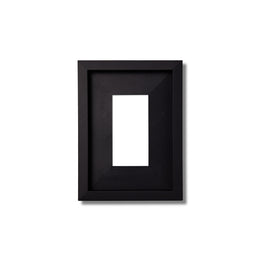Not sure what size frame you need? Whether you’re framing a postcard, a print, a picture, or a bespoke-sized artwork, use our free picture frame calculator to take the guesswork out of framing.
Here’s the quickest way to find the right size — and get it up on your wall.
How to choose the right frame (and avoid the pitfalls)
Let’s get this bit clear: don’t choose a frame based on its outer dimensions. It’s one of the most common mistakes people make — and the quickest way to end up with something that doesn’t fit.
Instead, always look for the window size (also called the aperture) — that’s the space your artwork will actually sit behind.
Here are a few other pitfalls to steer clear of:
- Don’t assume standard sizes will work. A5, A4, and 5x7” are helpful, but if your art’s even slightly off those dimensions, you’ll likely need something more adaptable — or a frame with a larger inner area.
- Don’t measure the paper if the image doesn’t go to the edge. It’s the visible part that matters.
- Don’t overcomplicate it. You don’t need to know every frame size on the internet — just the one that works for your piece.
If you’re asking “what size frame do I need?” — a frame sizing tool can take out all the mental gymnastics.
Find the right frame size with a picture frame calculator
A good picture frame calculator is the simplest way to match your artwork to the right size without second-guessing. Enter your artwork’s dimensions and it’ll suggest the best fit — whether that’s a standard size or something a little more flexible.
At Pop-up Frames, we built one that pairs your measurements with our adaptable frame kits. Just plug in the height and width of your artwork, and we’ll tell you whether to go for a Small or Medium kit. Each one covers a range of sizes, so even in-between dimensions are sorted.
Our kits are cut-to-size and made to work around real-life art — not the other way around.
Try the picture frame calculator.
How to correctly measure your artwork
Before you use any sizing tool, make sure you’re taking the right dimensions.
Here’s how to do it:
- Measure the visible area only. Don’t include borders or white space — just what you want to be seen through the frame.
- Use centimetres or millimetres. It gives a more accurate read than inches, especially for smaller pieces.
- Use a flat surface. Lay your artwork down and measure with a ruler or tape measure from edge to edge.
- Double-check. You only need to do it once — but doing it right saves a lot of hassle.
And remember: if you’re somewhere between sizes, it’s usually better to size up if your frame allows. With Pop-up Frames, trimming is always an option.
Why not ditch the faff altogether and try a cut-to-size frame instead?
Instead of an unsustainable, single-size frame, why not try one of our cut-to-size Pop-up Frames instead? They’re made in the EU with 100% FSC certified materials, and they look fantastic.
With peel & stick wall mounts included, your frame will be on the wall in minutes.
Frequently asked framing questions
What size frame do I need for A4 artwork?
A4 artwork measures 21 x 29.7 cm. You can either use a frame that fits A4 exactly or choose one that’s slightly larger if you want to add a mount or border. Pop-up Frames can be trimmed to fit A4 and similar sizes with ease.
How do I measure artwork for a picture frame?
Measure only the visible part of your artwork — the area you want to show through the frame. Use a ruler or tape measure, and always work in millimetres or centimetres for accuracy.
Can I frame something that’s not a standard size?
Yes. If your artwork doesn’t fit A-sizes or typical photo dimensions, cut-to-size frame kits like Pop-up Frames are ideal. They’re designed to adapt to the art, not the other way around.
Is it better to size up or down when framing?
If your art is in between sizes, it’s usually better to size up. You can always trim down the frame strips or add a border — but you can’t stretch a frame that’s too small.

























